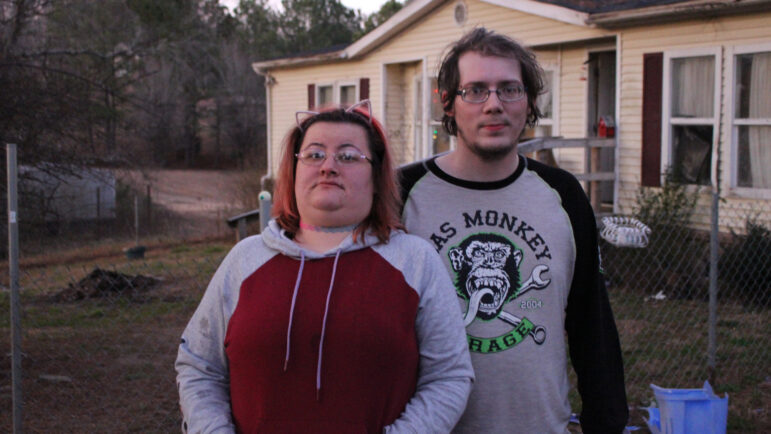The weekend after Thanksgiving, Krissy Harmon woke up around 2 a.m. to the smell of smoke.
“I actually thought the house was on fire,” Harmon recalled.
The fumes were coming from the nearby landfill, a 13-acre burning pit about half a mile up the hill from Harmon’s house in St. Clair County, Ala.
“As soon as I figured out that it was a fire that was affecting the landfill, I thought that they would put it out,” Harmon said.
But more than two months later, the fire is still fuming, both underground and at the surface. And it’s causing a laundry list of health concerns for Harmon and her neighbors.
“Nosebleeds and upper respiratory junk,” said Harmon. “Headaches have been terrible.”
“Cough, congestion, sinus problems, headaches, nosebleeds, chest pains,” said Frank Read, who lives directly in front of the landfill on Annie Lee Road.
“Sinus issues for sure, coughing, headaches, dizziness,” said Daniel Cash, who lives a few houses down the street from the fire.
What’s burning?
In total, more than 500 people live within one mile of the smoldering pit, which sits in the middle of a wooded residential area near Moody.
“Two months is a long time to be in the proximity of a burning landfill, especially one that we may not be entirely sure what’s in the landfill,” said Jeff Wickliffe, professor of environmental health sciences at UAB.
The privately-owned landfill, which operates under the name Environmental Landfill, Inc., is not regulated by state officials. It is described as a “vegetative waste disposal site,” authorized to accept natural debris, such as trees and leaves. But according to reports filed by the Alabama Department of Environmental Management (ADEM), the dump has previously been cited for containing non-natural waste like appliances, power poles and construction materials.
Since the fire started in late November, residents have complained about noxious fumes and air pollution. In early January, state officials asked the Environmental Protection Agency (EPA) to conduct air sampling, which revealed above normal levels of several toxic chemicals.
The detected pollutants could shed more light on what might be burning at the site.
Trichloroethylene (TCE), identified in air samples taken on the landfill property, is used as an industrial solvent and is only found in non-natural products like paint thinners. Both benzene and 1,3-butadiene, which were detected at above-normal levels at residential homes surrounding the fire, are known to come from burning wood, as well as burning rubber and plastics.
The toxic pollutants have been linked to serious health problems, like cancer and cardiovascular issues, but health experts say it’s difficult to predict the short and long-term impact on residents exposed to the landfill fumes.
According to officials with the Centers for Disease Control and Prevention (CDC), “the potential for harm depends on how high the levels were and how long the exposure lasted, along with personal traits and habits.”
Wickliffe said there’s a lack of comparative data.
“A lot of what we know about the short-term immediate health effects of a lot of these chemicals are really based on very high concentrations, much higher than what you find here,” Wickliffe said. “We really don’t know what the effects might be over, say, a two-month period for some of these.”
In general, smoke inhalation is never good, especially for people with pre-existing conditions like asthma, chronic obstructive pulmonary disease and heart disease.
Treating the symptoms
ADEM officials have advised residents to stay inside, seek medical care if they feel sick and relocate if necessary, a response that frustrates many residents.
“For some people, it may be an option, but definitely not everybody can just pick up and go,” said Cash, who lives in an old mobile home down the hill from the landfill on Annie Lee Road.
Cash said he and his fiancé can’t afford to stay in a hotel, and they’ve never been able to get approved for homeowners insurance, which has helped some residents pay for relocation expenses during the fire.
While Harmon and her family do have insurance, they still aren’t able to leave their home.
“We have a disabled child. We can’t really take him just anywhere,” Harmon said.
Harmon’s insurance has helped pay for professional air scrubbers and seven air purifiers. The family has also lined their windows and doors with blue painters tape, desperate to keep toxic fumes from entering the house.
Read, whose house sits right across the street from the flames, has spent hundreds of dollars on purifiers and cleaning supplies, but he cannot escape the smoke.
He and his 17-year-old son have both been prescribed nasal sprays, antibiotics and steroids to help with symptoms.
Read is hopeful the EPA will soon extinguish the fire. The agency stepped in last week and is working to smother the burning landfill with dirt, a process which could take another month.
But even if the flames are put out, Read worries about lingering impacts.
“Who knows what could happen 10 years from now. I mean, am I gonna end up with some weird cancer that’s rare and maybe treatable, maybe not?” Read said. “I mean those are the things that we all have to live with now.”
The EPA has a site profile with data from the agency’s air monitors and updates on efforts to smolder the fire and mitigate the smoke.
Read said he and his neighbors will always wonder what chemicals might have been burning weeks ago, before anyone ever tested the air.
WBHM’s Zoe McDonald contributed reporting to this story.

